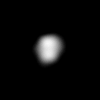 Belinda viewed by Voyager 2 in 1986 Belinda viewed by Voyager 2 in 1986 | |
| Discovery | |
|---|---|
| Discovered by | Stephen P. Synnott / Voyager 2 |
| Discovery date | January 13, 1986 |
| Designations | |
| Designation | Uranus XIV |
| Pronunciation | /bəˈlɪndə/ |
| Adjectives | Belindian |
| Orbital characteristics | |
| Semi-major axis | 75 255.613 ± 0.057 km |
| Eccentricity | 0.00007 ± 0.000073 |
| Orbital period (sidereal) | 0.623527470 ± 0.000000017 d |
| Inclination | 0.03063 ± 0.028° (to Uranus' equator) |
| Satellite of | Uranus |
| Physical characteristics | |
| Dimensions | 128 × 64 × 64 km |
| Surface area | ~22000 km |
| Volume | ~270000 km |
| Mass | ~(1.4–2.3)×10 kg |
| Mean density | 0.5–0.84 g/cm |
| Surface gravity | ~0.002–0.015 m/s |
| Escape velocity | ~0.017–0.031 km/s |
| Synodic rotation period | synchronous |
| Axial tilt | zero |
| Albedo | 0.08 ± 0.01 |
| Temperature | ~64 K |
| |
Belinda is an inner satellite of the planet Uranus. Belinda was discovered from the images taken by Voyager 2 on 13 January 1986 and was given the temporary designation S/1986 U 5. It is named after the heroine of Alexander Pope's The Rape of the Lock. It is also designated Uranus XIV.
Belinda belongs to the Portia group of satellites, which also includes Bianca, Cressida, Desdemona, Portia, Juliet, Cupid, Rosalind, and Perdita. These satellites have similar orbits and photometric properties. Other than its orbit, size of 128 × 64 km, and geometric albedo of 0.08, virtually nothing is known about it.
Voyager 2 images show Belinda as an elongated object with its major axis pointing towards Uranus. The moon is very elongated, with its short axis 0.5 ± 0.1 times the long axis. Its surface is grey in color.
Belinda is in a stable 44:43 mean-motion resonance with Perdita, and from this its mass has been determined to be roughly 26 times that of Perdita.
The inner moon system is unstable over timescales of several millions of years. Belinda and Cupid will probably be the first pair of moons to collide, in 100,000 to 10 million years' time depending on the densities of the Portia-group satellites, due to resonant interactions with the much smaller Cupid.
See also
Notes
- ^ Calculated on the basis of other parameters.
- Volume derived from the long axis A, the medium axis B and the short axis C:
- It is known that Belinda is 26 times the mass of Perdita. Perdita has a mean radius of 13.3±0.7 km and a density at maximum of 0.9 g/cm, meaning its mass is at maximum 8.87×10 kg, which makes Belinda's mass at maximum 2.3×10 kg.
- Maximum density obtained from the calculated maximum mass and the presupposed volume of ~270000 km.
- Surface gravity derived from the mass m, the gravitational constant G and the radius r:
- Escape velocity derived from the mass m, the gravitational constant G and the radius r:
References
Citations
- Benjamin Smith (1903). The Century Dictionary and Cyclopedia.
- ^ Jacobson 1998.
- ^ Karkoschka, Voyager 2001.
- ^ French, Robert S.; Showalter, Mark R.; de Pater, Imke; Lissauer, Jack J. (2017-10-01). Orbital and Photometric Analysis of the Inner Uranian Satellites from Hubble Images. Vol. 49. p. 214.19.
- Showalter & Lissauer 2006.
- ^ Ćuk et al. 2022.
- Showalter & Lissauer (2006), as cited in Ćuk et al. (2022).
- ^ French, Robert S.; Showalter, Mark R. (August 2012). "Cupid is doomed: An analysis of the stability of the inner uranian satellites". Icarus. 220 (2): 911–921. arXiv:1408.2543. Bibcode:2012Icar..220..911F. doi:10.1016/j.icarus.2012.06.031. S2CID 9708287.
- ^ Karkoschka, Hubble 2001.
- IAUC 4164.
- USGS: Planet and Satellite Names and Discoverers.
Sources
- Jacobson, R. A. (1998). "The Orbits of the Inner Uranian Satellites From Hubble Space Telescope and Voyager 2 Observations". The Astronomical Journal. 115 (3): 1195–1199. Bibcode:1998AJ....115.1195J. doi:10.1086/300263. S2CID 118616209.
- Karkoschka, Erich (2001). "Voyager's Eleventh Discovery of a Satellite of Uranus and Photometry and the First Size Measurements of Nine Satellites". Icarus. 151 (1): 69–77. Bibcode:2001Icar..151...69K. doi:10.1006/icar.2001.6597.
- "Planetary Satellite Physical Parameters". JPL (Solar System Dynamics). 18 October 2010. Retrieved 2012-01-27.
- Williams, Dr. David R. (23 November 2007). "Uranian Satellite Fact Sheet". NASA (National Space Science Data Center). Retrieved 2012-01-27.
- Karkoschka, Erich (2001). "Comprehensive Photometry of the Rings and 16 Satellites of Uranus with the Hubble Space Telescope". Icarus. 151 (1): 51–68. Bibcode:2001Icar..151...51K. doi:10.1006/icar.2001.6596.
- Marsden, Brian G. (1986-01-16). "Satellites of Uranus". IAU Circular. 4164. Retrieved 2012-01-27.
- USGS/IAU (July 21, 2006). "Planet and Satellite Names and Discoverers". Gazetteer of Planetary Nomenclature. USGS Astrogeology. Retrieved 2012-01-27.
- Ćuk, Matija; French, Robert S.; Showalter, Mark R.; Tiscareno, Matthew S.; Moutamid, Maryame El (2022-07-16). "Cupid is not Doomed Yet: On the Stability of the Inner Moons of Uranus". The Astronomical Journal. 164 (2): 38. arXiv:2205.14272. doi:10.3847/1538-3881/ac745d. ISSN 1538-3881.
- Showalter, Mark R.; Lissauer, Jack J. (17 February 2006). "The Second Ring-Moon System of Uranus: Discovery and Dynamics". Science. 311 (5763): 973–977. doi:10.1126/science.1122882.
External links
| Uranus | |||||||
|---|---|---|---|---|---|---|---|
| Geography | |||||||
| Major moons | |||||||
| Astronomy |
| ||||||
| Exploration |
| ||||||
| Related | |||||||
| Moons of Uranus | |||||
|---|---|---|---|---|---|
| |||||
| Inner | |||||
| Major (spheroid) | |||||
| Outer (irregular) |
| ||||
| Geological features | |||||
| Natural satellites of the Solar System | ||
|---|---|---|
| Planetary satellites of |   | |
| Dwarf planet satellites of | ||
| Minor-planet moons | ||
| Ranked by size | ||


